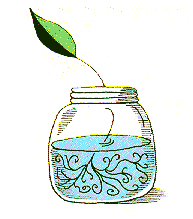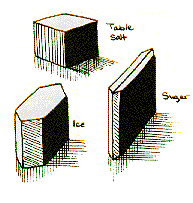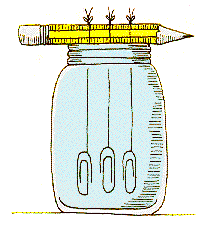PLANTS
Plants are the only things on earth that turn sunlight into food. They do it through a process called photosynthesis, which is explored in this activity.
 What you'll need
What you'll need
Some household plants
A book on plant care from the library
Grown-up alert!
Plant fertilizer
Paper
Scissors
Your magnifying glass
Your science journal
What to do
- Look in your plant-care book, or ask a grown-up, to find out how much water each plant needs. Some may need to be watered more than others.
- Take two clippings from one plant. Put one in a glass of water. Put the other one in a glass with no water. Check each day to see how long the one without water can survive.
- Water the rest of the plants each week for several weeks. Fertilize some of the plants but not others during this time. Label the ones you fertilized.
- Record the following in your science journal for those plants that got fertilized and for those that didn't:
- Did any of the plants start to droop?
- Did any of the plants have yellow leaves that fell off?
- Did the plants grow toward the light?
- See what happens when a plant (or part of a plant) doesn't get any light:
- Cut 3 paper shapes about 2 inches by 2 inches. Circles and triangles work well, but you can experiment with other shapes, too.
- Clip them to the leaves of a plant, preferably one with large leaves. Either an indoor or an outdoor plant will do. Be very careful not to damage the plant.
- Leave one paper cutout on for 1 day, a second on for 2 days, and a third on for a week.
- How long does it take for the plant to react? How long does it take for the plant to return to normal?
Photosynthesis means to "put together using light". Plants use sunlight to turn carbon dioxide from the air, and water into food. Plants need all of these to remain healthy. When the plant gets enough of these things, it produces a simple sugar, which it uses immediately or stores in a converted form of starch. We don't know exactly how this happens. But we do know that chlorophyll, the green substance in plants, helps it to occur.
CRYSTALS
A crystal is a special kind of rock. Different crystals have different beautiful shapes and colors.
 What you'll need
What you'll need
Your magnifying glass
Table salt
Epsom salt
Honey jar
Measuring cups and spoons
Paper cut into circles
Scissors
Pencil
String
1 3/4 cups of sugar
2 or 3 paper clips
A glass jar or drinking glass
Your science journal
What to do
- Use your magnifying glass to look for crystals. Inspect:
- The table salt and Epsom salt;
- The honey jar (particularly if it has been open for awhile); and
- The walls of the freezer (if it's not the frost-free kind).
- Draw pictures of what you see in your science journal.
- Do all of the crystals look the same?
- If not, how are they different?
- Try dissolving salt crystals and forming new ones:
- Dissolve 1 teaspoon of salt in 1 cup of water.
- Grown-up alert!
- Heat the mixture over a low flame to evaporate the water.
- What's left?
- What shape are these crystals?
- Snowflakes are made of ice crystals and are beautiful, but they are hard to see clearly. You can make paper snowflakes.

- Take a circle of paper (use thin paper) and fold it in half. Then fan fold it.
- Make cuts along all the edges. Unfold them.
- Grow rock candy crystals from dissolved sugar.

- Grown-up alert!
- Pour a cup of boiling water into a dish and add 1 3/4 cups of sugar. Stir until the sugar is completely dissolved. Prepare a jar or glass as shown.
- Wash the paper clips and use clean string. When the sugar water is cool, pour it into the jar and put it where no one will move it. Hang the paperclips in the water and put the pencil on top of the jar.
- Some crystals may form in a few hours. Some may grow to be half an inch on each side. To save them, take them out of the water and keep them dry. But they may disappear - they are good to eat.
When certain liquids and gases cool and lose water, crystals are formed. Crystals are made up of molecules that fit neatly together in an orderly package. All crystals of the same material have the same shape, regardless of the size.